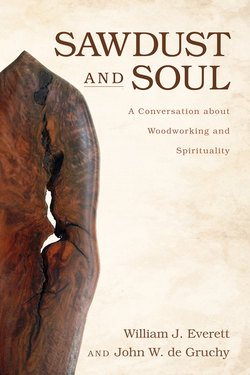Читать книгу Sawdust and Soul - John W. de Gruchy - Страница 7
About This Book
ОглавлениеWe were originally drawn together by our common interest in theology and public life, with me in the United States and John in South Africa. But we soon discovered another deep connection—a love for wood and woodworking. Early on in our friendship when John was visiting us in Boston, we went together to a party in one of the grand old homes near where Sylvia and I lived. All the wood paneling, the floors, and the furniture in the house were made out of cherry. It was a stunning testament to a time of giant trees and elegant craftsmanship. We marveled together about the wood and the craft while others milled about in academic conversation. Our friendship in wood had previously begun one evening in Cape Town the year before. But now it was sealed and our conversation began in earnest.
Over the years since then we have talked off and on about the way working with wood has shaped not only how we work with words, but how we live our lives. Woodworking has been a life-giving complement to our work as academic theologians. Like many others, in our retirement this work of our hands has become a transforming vehicle for discerning what it is to live a life “in the spirit.” Woodworking has been essential for navigating our way into this phase of our lives—in my case more as a fresh expression of my previous interests, in John’s more as a necessary complement— bringing balance and enabling fresh creativity. So it was that for John’s retirement colloquium at the University of Cape Town in May 2003, I presented a paper about woodworking, spirituality, and ethics, in which I lifted up the importance of woodworking for his theological work. Much to the amazement and fascination of his colleagues from around the world, John also displayed, and then we commented on, some of his turned bowls and other outcomes of his woodcraft.
In this little book we share some reflections on the way this life with wood has brought about a broadening and deepening of our own lives. We use our experience not just to craft meditations illustrating previously held convictions, but as an entrance into new understandings, practices, and sensibilities. In doing so, we invite you to join our conversation about the ways woodworking has shaped our “spirituality,” our way of being in the world, whether you are an “all thumbs” theologian, a seeker, a pilgrim, or a practical woodworker. We’ve even included a glossary at the end to help you with any terms with which you may not be familiar, and had some fun in compiling it. While we both speak and write our own form of English, we decided to use American spellings and retain the Imperial measurements of feet and inches, even though we both agree the metric system is far easier for woodworking! But we use both the American “shop” and the British “workshop” to describe the place where we do our woodworking.
We need to make clear that this is not a handbook for woodworking. While we describe some of our experiences and techniques, we are not seeking to instruct you in woodworking. For that you can turn to one of the fine books or magazines noted in the bibliography or, if you are so fortunate, to programs at your local schools or woodworking clubs. And please be mindful that while woodworking is a great hobby, it involves sharp tools and machinery. So make sure you take all safety rules seriously.
We’ll start with how we got into this craft. Then we’ll talk about the way the world of trees that we inhabit has shaped not only us but our whole culture. We then turn to what we have learned from some of our own projects. At the end we’ll reflect on how woodworking takes place in communities of relationships between generations and among friends.
Working with wood can be a deeply solitary activity, but it always takes place in relationships—with wood as well as people. Among these are the many associations, clubs, and informal networks that have enabled us to improve our woodworking. There are also many people to thank for this journey—parents and grandparents, wives and sisters, children and grandchildren, colleagues, and friends in wood. You’ll hear us talking about our friends who have helped us with their skills, their tools, their shops, and their thoughts about the craft they love. The voices of our children will also enter the conversation as they pick up in their own ways where we leave off. We also want to give a special thanks to Isobel de Gruchy, who has graciously supplied the line drawings of tools that beautify the book’s transitions, labored over the production of the photos accompanying the text, and also made some editorial suggestions.
Well, John, let’s start talking! The project is waiting. Why don’t you kick off and tell us something about your life in woodworking?
